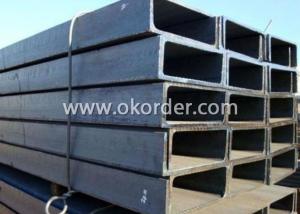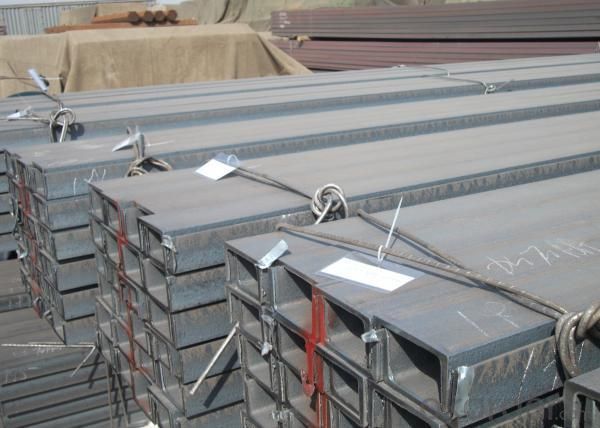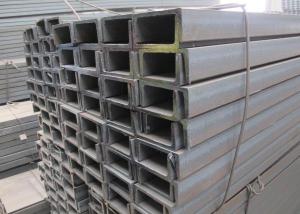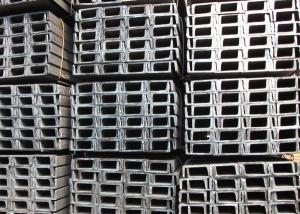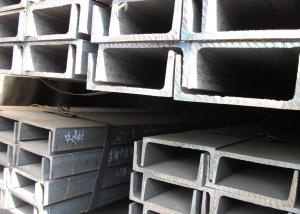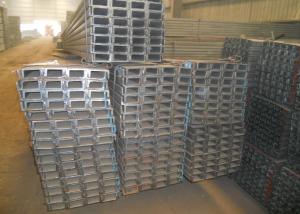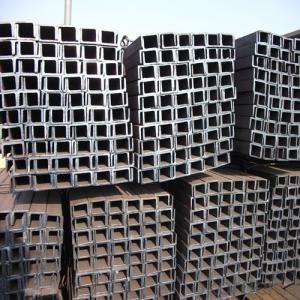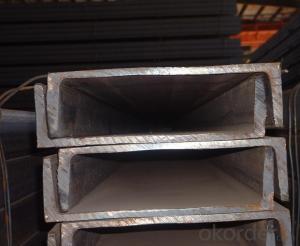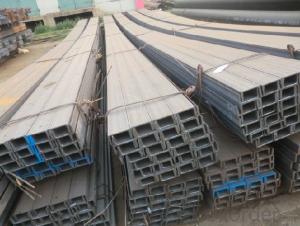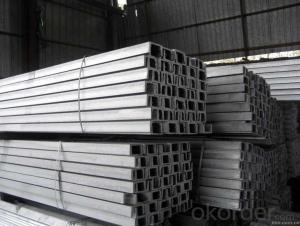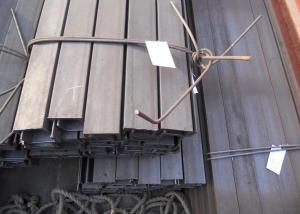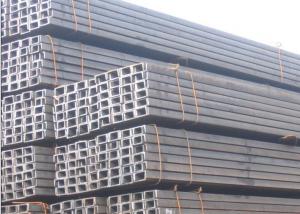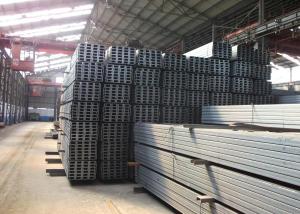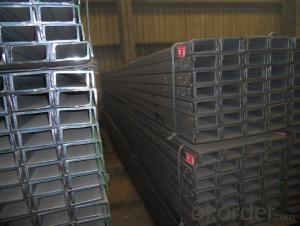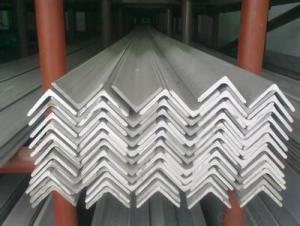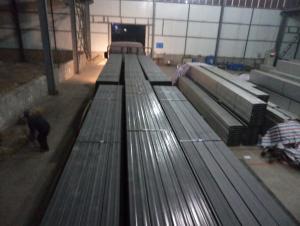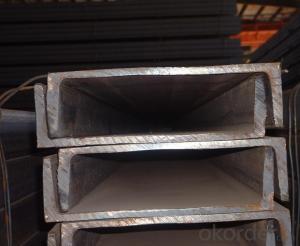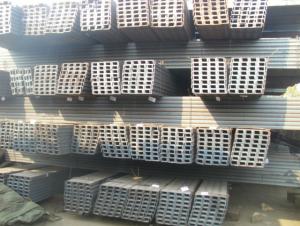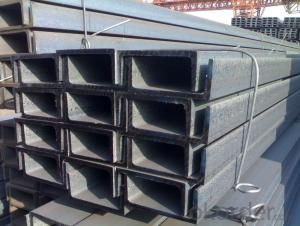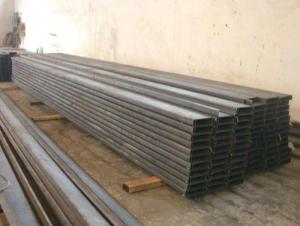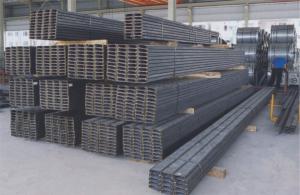Channel Steel UPN
- Loading Port:
- Xingang Port
- Payment Terms:
- TT or LC
- Min Order Qty:
- 25 m.t.
- Supply Capability:
- 80000-100000MTS/YEAR m.t./month
OKorder Service Pledge
OKorder Financial Service
You Might Also Like
Specifications of UPN Channel Steel:
1.Our UPN Channel Steel has lots of advantages, just as followings:
a) At reasonable price and good quality.
b) To be convenient in construction and to save much time and labor.
c) The length of UPN can be manufactured according to customer’s requirements.
d) The UPN Channel Steel has strong mechanical strength.
e). The UPN Channel Steel possesses various kind of fittings, through which it is suitbal for many combinations.
f) Our UPN Channel Steel is attractive in appearance as well as beautiful in design
g) Free from slotted punching
2. The detailed sections of our UPN Channel Steel can be found in table-1
|
UPN U CHANNEL |
Standard h |
Sectional b |
Dimension s |
t |
Mass: Kg/m |
|
|
(mm) |
(mm) |
(mm) |
(mm) |
|
|
80x45 |
80 |
45 |
6.0 |
8.0 |
8.64 |
|
100X50 |
100 |
50 |
6.0 |
8.5 |
10.6 |
|
120x55 |
120 |
55 |
7.0 |
9.0 |
13.4 |
|
140x60 |
140 |
50 |
7.0 |
10.0 |
16.0 |
|
160x65 |
160 |
65 |
7.5 |
10.0 |
18.8 |
|
180x70 |
180 |
70 |
8.0 |
11.0 |
22.0 |
Table-1
Note: we are definitely good at manufacturing and supplying UPN channel steel as per S235JR. Also, we are willing and able to provide our customers UPN channel steel in other sizes, which depends on customers’ concret requirements for the quantity.
3. The chemical composition of UPN Channel Steel as per S235JR is shown in the table-2
|
Alloy No |
Element(%) | ||||
|
C |
Mn |
S |
P |
Si | |
|
S235JR |
0.12—0.20 |
0.3—0.7 |
≤0.030 |
≤0.030 |
≤0.20 |
Table-2
4. The mechanical property of UPN Channel Steel as per S235JR is shown in the table-3-1 and table-3-2
|
Alloy No |
Yielding strength point( Mpa) | |||
|
Thickness (mm) | ||||
|
≤16 |
>16--40 |
>40--60 |
>60--100 | |
|
≥ | ||||
|
S235JR |
235 |
225 |
215 |
195 |
Table-3-1
|
Alloy No |
Tensile strength (Mpa) |
Elongation after fracture(%) | |||
|
Thickness (mm) | |||||
|
|
≤16 |
>16--40 |
>40--60 |
>60--100 | |
|
≥ | |||||
|
S235JR |
340--510 |
24 |
23 |
22 |
27 |
Table-3-2
Applications of UPN Channel Steel:
The UPN Channel Steel can be applied to construction of warehouses, workshops, sport stadiums and car parks etc.The hot rolled channel steel belongs to carbon structural steel which is applied to in the field of construction and machinery.In details, the hot rolled channel steel is usually used for arch-itechtural structure, and they could be welded in order to support or hang a vari-ety of facilities. They are also usually used in combination with I beam. Generally,the hot rolled channel steel we supply must possess perfect welding property, riveting property and mechanical property and so on.
Package & Delivery of UPN Channel Steel:
1.The channel steel will be packed in bundle with steel wire at each end of every bundle and color marking in order to help the customer to recognize his goods more easily at sight.
2. And the channel steel could be loaded into 20ft or 40ft container, or by bulk cargo.If the weight of each bundle reaches more than 3.5 mt, the loading by break bulk cargo should be choosed.When the weight of each bundle reaches less than 3mt, the loading by container should be choosed.
3.As for the transportaion from mill to loading port, the truck will be usually used. And the maximum quantity for each truck is 40mt.
4.All in all, we could do in accordance with customer's request.
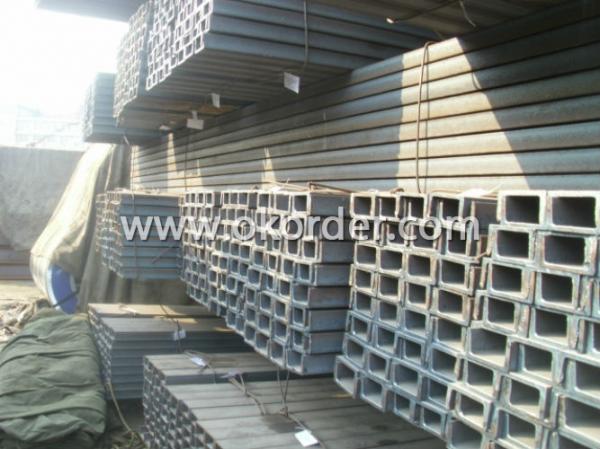
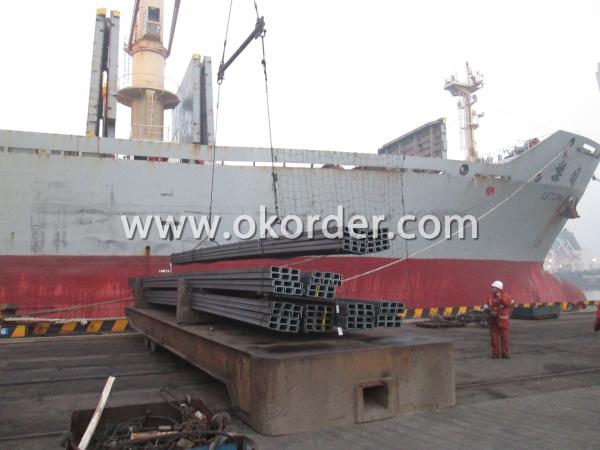
Production Flow of Steel U Channel:
1.The steel billet shall be heated in the high temperature furnace.
2. The heated steel billet shall be rolled five to nine times with the aim of shaping the general figure of steel u channel.
3. The rolled steel u channel should be put onto the cooling bed to make the temperature low.
4. The steel u channel should be straighted on the straightener.
5. The straighted steel u channel will be cut into meters by saw, as per customer's requirements.
6. At the last part of production, the channel steel must be tested in order to confirm that the finished products are completely free from crack, pore, slag, scab or fold on the surface.
- Q: Are steel channels suitable for use in corrosive environments?
- No, steel channels are not suitable for use in corrosive environments as they are prone to rust and corrosion.
- Q: How do steel channels contribute to the overall energy performance of a building?
- Steel channels can contribute to the overall energy performance of a building in several ways. Firstly, steel channels are commonly used as structural elements in a building's framing system. They provide strength and support to the structure, allowing for efficient load distribution and reducing the need for excessive materials. This, in turn, can help to reduce the overall energy consumption during the construction phase. Additionally, steel channels can be utilized in the building envelope, specifically in the insulation and air sealing systems. By properly installing steel channels as part of the framing system, it allows for the effective placement of insulation materials. Proper insulation helps to minimize heat transfer through the walls, roof, and floors, improving the building's energy efficiency and reducing the need for heating and cooling. Moreover, steel channels can contribute to the overall energy performance of a building by providing stability and durability. Steel is known for its high strength-to-weight ratio, which allows for the creation of lighter and more efficient structures. This not only reduces the amount of materials required but also enables the construction of larger window openings. By incorporating larger windows, buildings can maximize natural light and reduce the need for artificial lighting during the day, resulting in energy savings. Furthermore, steel channels can support the installation of renewable energy systems, such as solar panels or wind turbines. These channels can be used to securely mount and position these systems, optimizing their exposure to the sun or wind, which leads to increased energy generation and reduced reliance on conventional energy sources. In summary, steel channels contribute to the overall energy performance of a building by providing structural integrity, enabling efficient insulation and air sealing, facilitating natural lighting, and supporting renewable energy systems. By incorporating steel channels in the design and construction processes, buildings can achieve improved energy efficiency, reduced energy consumption, and ultimately a smaller environmental footprint.
- Q: How do steel channels contribute to the overall stability of a telecommunications tower?
- Steel channels play a crucial role in contributing to the overall stability of a telecommunications tower. These channels, which are often made of high-strength steel, provide structural support and reinforcement to ensure the tower can withstand various external forces. One key way steel channels contribute to stability is by distributing the weight of the tower evenly across its foundation. The channels are strategically placed to bear the load and transfer it to the ground, preventing any excessive stress on specific parts of the tower. This helps to minimize the risk of structural failure or collapse. Moreover, steel channels enhance the tower's resistance against wind loads. Telecommunications towers are exposed to strong winds, which can exert significant pressure on their structure. Steel channels work as braces, providing additional rigidity and preventing the tower from swaying excessively. By reducing the tower's movement in response to wind forces, steel channels ensure stability and reduce the risk of damage or toppling over. Additionally, steel channels help to maintain the tower's stability during seismic events. Earthquakes or ground vibrations can pose a significant threat to the structural integrity of a telecommunications tower. By integrating steel channels into the tower's design, it becomes more resistant to lateral forces, ensuring it can withstand the shaking motion caused by seismic activity. Furthermore, steel channels also contribute to the tower's overall durability and longevity. The high-strength steel used in these channels is known for its excellent tensile strength and resistance to corrosion. This allows the tower to maintain its structural integrity over time, even in harsh environmental conditions. In summary, steel channels play a vital role in enhancing the overall stability of a telecommunications tower. Their ability to distribute weight, resist wind loads, withstand seismic activity, and provide long-term durability ensures the tower can safely support the equipment and infrastructure necessary for reliable telecommunications services.
- Q: Are steel channels suitable for use in storage racks?
- Yes, steel channels are suitable for use in storage racks. Steel channels are designed to provide structural support and strength, making them ideal for storing heavy items or materials on racks. They offer high load-bearing capacity, durability, and resistance to bending or warping, which ensures the stability and safety of the storage racks. Moreover, steel channels can be easily customized and adjusted to fit specific storage requirements, making them versatile for various storage applications. Overall, steel channels are a reliable and efficient choice for constructing storage racks.
- Q: Which kind of wind resistance is better for square tube, square tube or channel steel?
- Why don't you buy square tubes directly? How do you budget?
- Q: How do steel channels perform in high-temperature environments?
- Steel channels typically perform well in high-temperature environments due to their inherent strength and durability. The properties of steel, such as its high melting point and resistance to thermal expansion, make it suitable for use in elevated temperatures. Steel channels can withstand high temperatures without significant deformation or loss of structural integrity. One of the main reasons steel channels are effective in high-temperature environments is their ability to retain their mechanical properties at elevated temperatures. Steel has a high thermal conductivity, which allows it to effectively dissipate heat and prevent excessive temperature rise. This property helps to maintain the structural stability of steel channels even when exposed to high heat. Moreover, steel channels are often designed to have a high fire resistance rating. This is achieved by incorporating fire-resistant coatings or fireproofing materials to enhance their performance in extreme temperatures. These measures help to protect the steel channels from the detrimental effects of heat, including weakening or deformation. It is important to note that the performance of steel channels in high-temperature environments can be influenced by factors such as the specific grade of steel used and the duration of exposure to elevated temperatures. Different grades of steel have varying thermal properties, so it is crucial to select the appropriate grade based on the specific temperature requirements of the application. In summary, steel channels generally perform well in high-temperature environments. Their strength, durability, and ability to retain mechanical properties make them suitable for use in such conditions. However, it is recommended to consult with experts or refer to the manufacturer's specifications to ensure the steel channels are selected and utilized correctly for optimal performance in high-temperature environments.
- Q: Is there anything wrong with weight bearing? The total area of 15 square meters. The attic floor estimate 18MM blockboard, in addition to the requirements of the attic can go up two people outside bearing on it. Don't put articles, is a flat top and a heat insulation function. Can each channel be spaced 70 or 80 centimeters apart? In addition, 10, how much money a channel, the best is 9 meters a price of 6 meters is also ok.
- No channel steelWith 100~120 rectangular square tube or 120 C steel, two channel steel price can buy 3 square tubesThe board specification is 1.2*2.4m, so the steel beam spacing should be 60cm; the bone is 30*50 square tube and the spacing is 60cmThe span of 3.9m, bearing no problem, you can turn a somersault roll, O (a _ U) O~
- Q: Can steel channels be used for sign supports?
- Yes, steel channels can be used for sign supports. Steel channels are often used in construction and engineering projects due to their strength and durability. They are commonly used in applications where a high load-bearing capacity is required, making them suitable for supporting signs. Steel channels can be easily fabricated and customized to meet specific requirements, and they offer excellent resistance to weathering and corrosion, ensuring the longevity of sign supports. Additionally, steel channels provide stability and rigidity, ensuring that signs remain securely in place even in harsh environmental conditions.
- Q: Many of the equipment in the substation is installed on the support of the channel, why not directly mounted on the support plate. Why should we add channel steel to the top plate?What effect can this channel play?
- Keep all switchgear in good condition;
- Q: Are steel channels available in pre-fabricated lengths?
- Yes, steel channels are available in pre-fabricated lengths.
1. Manufacturer Overview
| Location | Tangshan, China |
| Year Established | 2000 |
| Annual Output Value | Above US$ 50 Million |
| Main Markets | Mid East; Southeast Asia; Korea |
| Company Certifications |
2. Manufacturer Certificates
| a) Certification Name | |
| Range | |
| Reference | |
| Validity Period |
3. Manufacturer Capability
| a) Trade Capacity | |
| Nearest Port | Tianjin |
| Export Percentage | 20% - 30% |
| No.of Employees in Trade Department | 10-20 People |
| Language Spoken: | English; Chinese |
| b) Factory Information | |
| Factory Size: | Above 81,000 square meters |
| No. of Production Lines | 1 |
| Contract Manufacturing | OEM Service Offered |
| Product Price Range | Average |
Send your message to us
Channel Steel UPN
- Loading Port:
- Xingang Port
- Payment Terms:
- TT or LC
- Min Order Qty:
- 25 m.t.
- Supply Capability:
- 80000-100000MTS/YEAR m.t./month
OKorder Service Pledge
OKorder Financial Service
Similar products
Hot products
Hot Searches
Related keywords
